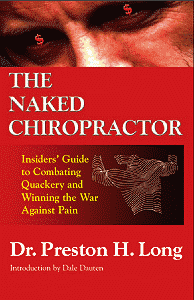
SEVEN DIED AFTER TREATMENT
Brad Evenson - National Post
April 30, 2004 - page A2
Families of seven Canadians who died after chiropractic neck
manipulation
are calling on politicians across the country to ban the practice,
which can
cause fatal strokes, paralysis and crippling brain injuries.
Increasingly, doctors and coroners blame the sharp twist of the spine's
top
two joints for harm to a delicate artery at the base of the brain.
"In our cases, the result was death," said a statement released by the
families. "In many hundreds of others, it is the lifelong effect of
stroke."
The families have sent 400 politicians across Canada a booklet and
videotape
with information from doctors and patients, including a plea from Diane
Rodrigue, an Ontario woman who won a $1-million settlement when she was
paralyzed after a chiropractic neck manipulation.
The Canadian Chiropractic Association says such cases are not common.
"There is a risk of complications associated with neck adjustment,
however,
the published research indicates that serious complications are very
rare,"
said Grayden Bridge, president of the Canadian Chiropractic
Association.
"This must be balanced by the fact that neck adjustment provides
benefits
for patients with neck pain, headaches and whiplash."
The families' campaign is the latest salvo in a running battle between
chiropractors and the medical profession.
Several years ago, more than 60 leading Canadian neurologists warned
about
the dangers of neck manipulation. Almost all of them have since
received
intimidating phone calls and e-mails.
In January, a Toronto coroner's jury found the death of Lana Dale
Lewis, 45,
was the accidental result of an upper-neck adjustment by chiropractor
Phillip Emanuele. The inquest was a fierce struggle, as witnesses were
discredited, stolen information appeared in brown envelopes and Ms.
Lewis's
personal character and health were assailed.
"If we had known what we were going to incur, I don't think we would
have
tackled it," says Ms. Lewis's sister, Wendy Abrams.
"We expected a fact-finding mission; instead, the chiropractors circled
the
wagons."
Another of Ms. Lewis's sisters, Judy Anne Ford, and her husband, Mike,
also
are involved in the campaign.
"For the chiropractors, this seemed to be a Gettysburg kind of thing,"
Mr.
Ford says, referring to a U.S. Civil War battle.
"While we were interested in getting at the truth, they were interested
in
victory."
Opponents of neck manipulation say X-rays and other evidence prove the
technique can weaken or tear the artery at the bony protuberance where
the
neck bones join the skull. In 2001, a Canadian study of 582 patients
younger
than 45, published in the journal Stroke, found they were five times
more
likely to have had a neck manipulation within a week of their strokes.
This is what happened to Laurie Mathiason, 20, who died after
chiropractic
treatment for pain in her tailbone. In 1998, a coroner's jury concluded
her
death resulted from traumatic rupture of the left vertebral artery.
"I vowed to my dying daughter that I was going to get to the bottom of
what
killed her," says her mother, Sharon Mathiason, who is part of the
campaign.
"And I screamed and yelled and ranted and raved at all kinds of people
across this country ..."
Ms. Mathiason is also angry at the efforts of chiropractors to treat
infants, an increasingly common practice.
Chiropractors say upper-neck manipulation helps to release points of
tension
they call "subluxations." However, there is little medical proof such
points
exist, or that twisting the upper vertebrae can relieve tension.
That could change. After the Lewis inquest, the Canadian Chiropractic
Association announced it is participating in three studies. These
include
research by Michael Hill, a University of Calgary neurologist and
epidemiologist, and Walter Herzog, the university's associate dean of
research in kinesiology.
In the meantime, the industry is defending itself against all comers,
including families. For example, in 2001, Ron Grainger, a retired
Alberta
doctor who suffered a massive stroke and died within days of a neck
manipulation. At first, the family stayed quiet about the incident.
"But then, through my practice, a patient of mine came in and said her
cousin had just had a massive stroke on the table while seeing a
chiropractor, and she was only 21 years old," says Mark Grainger, a
medical
doctor like his late father. Dr. Grainger said the College of
Chiropractors
does not investigate such incidents. "They're mostly denying they
exist," he
said.
So the Graingers have joined the campaign.
But Maureen McCandless, a spokeswoman for the Canadian Chiropractic
Association, says the family has no proof the manipulation killed Ron
Grainger.
"When asked quite pointedly what physical, physiological evidence there
was
to make that association ... Dr. Grainger said no, they did not have
that
evidence," she said.
Even so, Ms. McCandless said, the family is stepping forward yet again
with
unsubstantiated claims. And she said the association would not ask
members
to stop doing neck manipulations.
"There is no evidence that would indicate that that is a necessary
step."
E-mail Brad Evenson bevenson@nationalpost.com
KEVIN VAN PAASSEN / NATIONAL POST
Caption of picture: Judy Anne Ford's sister died after
receiving a chiropractic neck manipulation. A coroner's jury ruled the
death
an accidental result of the procedure, a conclusion the chiropractic
association disputed.
|











